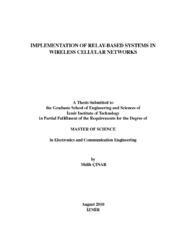Please use this identifier to cite or link to this item:
https://hdl.handle.net/11147/3067Full metadata record
| DC Field | Value | Language |
|---|---|---|
| dc.contributor.advisor | Özbek, Berna | - |
| dc.contributor.author | Çınar, Melih | - |
| dc.date.accessioned | 2014-07-22T13:50:49Z | - |
| dc.date.available | 2014-07-22T13:50:49Z | - |
| dc.date.issued | 2010 | - |
| dc.identifier.uri | http://hdl.handle.net/11147/3067 | - |
| dc.description | Thesis (Master)--Izmir Institute of Technology, Electronics and Communication Engineering, Izmir, 2010 | en_US |
| dc.description | Includes bibliographical references (leaves: 69-72) | en_US |
| dc.description | Text in English; Abstract: Turkish and English | en_US |
| dc.description | xiii, 72 leaves | en_US |
| dc.description.abstract | The wireless cellular networks are limited by interference and coverage issues where the users at the edge of the cell usually do not receive enough signal energy. To combat these problems and provide higher signal to interference noise ratio and capacity without increasing the transmit power, the idea of using relays in cellular networks was explored and evaluated in the literature. On the other hand, multiple input multiple output (MIMO) antenna systems have great potential to increase capacity and reliability of a wireless cellular network compared to single input single output systems. Hence, the integration of MIMO systems in the relay-based cellular networks has great potential to meet the growing demands of future communication. In this thesis, we explore the performances in conventional and relay-based wireless systems with single and multiple antennas by ad justing the frequency reuse factor as one and four. We consider wireless cellular based networks where six fixed relays are placed evenly in each cell in a hexagonal layout. A user chooses to receive the transmitted signal either directly from the base station or via one of the relays by employing selection algorithms. Throughout this thesis, we first determine the optimum relay locations considering different relay powers. Then, we investigate the system capacity for the cell with and without relays. Next, we examine the capacity performances by changing the cell diameter and the relay power. Finally, we explore the performances of relay based networks with multiple antennas. | en_US |
| dc.language.iso | en | en_US |
| dc.publisher | Izmir Institute of Technology | en_US |
| dc.rights | info:eu-repo/semantics/openAccess | en_US |
| dc.subject.lcsh | Wireless communication systems | en |
| dc.subject.lcsh | Radio relay systems | en |
| dc.title | Implementation of Relay-Based Systems in Wireless Cellular Networks | en_US |
| dc.type | Master Thesis | en_US |
| dc.institutionauthor | Çınar, Melih | - |
| dc.department | Thesis (Master)--İzmir Institute of Technology, Electrical and Electronics Engineering | en_US |
| dc.relation.publicationcategory | Tez | en_US |
| dc.identifier.wosquality | N/A | - |
| dc.identifier.scopusquality | N/A | - |
| item.fulltext | With Fulltext | - |
| item.languageiso639-1 | en | - |
| item.openairecristype | http://purl.org/coar/resource_type/c_18cf | - |
| item.grantfulltext | open | - |
| item.openairetype | Master Thesis | - |
| item.cerifentitytype | Publications | - |
| Appears in Collections: | Master Degree / Yüksek Lisans Tezleri | |
Files in This Item:
| File | Description | Size | Format | |
|---|---|---|---|---|
| T000884.pdf | MasterThesis | 3.61 MB | Adobe PDF |  View/Open |
CORE Recommender
Page view(s)
104
checked on May 12, 2025
Download(s)
58
checked on May 12, 2025
Google ScholarTM
Check
Items in GCRIS Repository are protected by copyright, with all rights reserved, unless otherwise indicated.